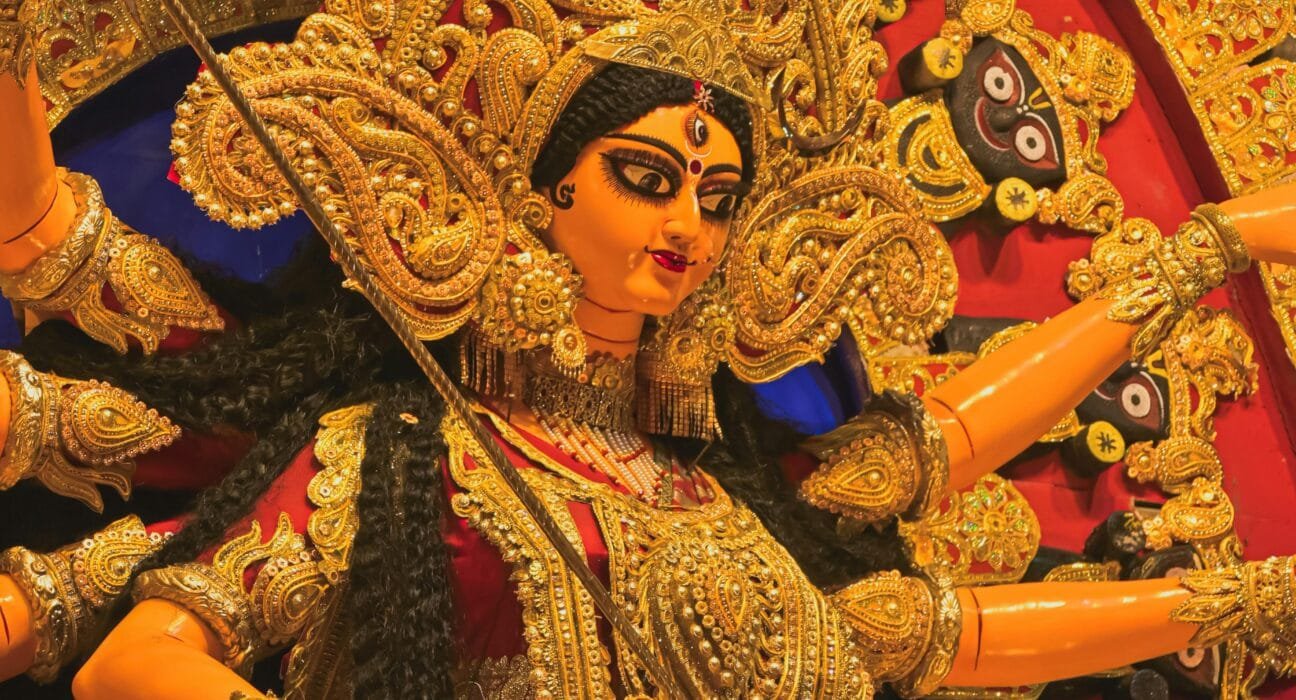Introduction
Ayudha Puja is a vibrant and significant festival celebrated in India, especially during the festive season of Dussera. This unique puja, dedicated to worshiping tools, equipment, and instruments, showcases the reverence for knowledge and craftsmanship. During this time, families and communities like Mysore honor the Goddess Mahishasuramardhini, a powerful representation of feminine strength and expertise, often associated with Saraswathi Puja.

What Is Ayudha Puja?
Ayudha Puja, which means “worship of tools,” is celebrated primarily in South India during the festival of Dussera. A spirit of gratitude and pride marks the festival for one’s work tools and implements. People from various professions gather to honor their tools, whether they are agricultural equipment, machinery, or artistic instruments. This puja serves to remind individuals of the value of hard work and the importance of skills in their lives.
The Connection Between Ayudha Puja And Dussera

Dussera, also known as Vijayadashami, symbolizes the victory of good over evil. It marks the end of the Navaratri festival, which emphasizes the power of the divine feminine. Ayudha Puja is intricately linked to Dussera, as it is performed on the same day when people celebrate the triumph of Goddess Durga over the buffalo demon, Mahishasura. Just as the goddess’s victory signifies strength and empowerment, Ayudha Puja celebrates the tools that empower individuals in their livelihoods.
Saraswathi Puja: The Goddess Of Knowledge
Saraswathi Puja often coincides with Ayudha Puja, focusing on the goddess of wisdom and learning. This day is particularly significant for students and educators as they pay respect to books, musical instruments, and other sources of knowledge. Many worshipers place their educational materials near the idol of Saraswathi, signifying a desire for enlightenment and proficiency in their studies and crafts.
Importance of Saraswathi:
- Goddess of Knowledge: Saraswathi is revered for her role in granting wisdom.
- Learning Rituals: Students are encouraged to participate in rituals, asking for blessings on their studies.
Legend Of Goddess Durga And The Mahishasura Mardini
The most widely known legend associated with Ayudha Puja is the slaying of the demon Mahishasura by Goddess Durga. According to Hindu mythology, Mahishasura was a powerful demon who could not be defeated by gods or men. He wreaked havoc across the three worlds, and the gods were helpless. They sought the help of Goddess Durga, who waged a fierce battle against Mahishasura for nine days. On the tenth day, which is celebrated as Vijayadashami, she killed him. The weapons she used during the battle are worshiped as part of Ayudha Puja, symbolizing the triumph of good over evil.
Worship Of Weapons By The Pandavas
Another legend comes from the Mahabharata. The Pandavas, during their 13-year exile, spent one year incognito. During this period, they hid their weapons in a Shami tree (Prosopis cineraria) and took up various civilian roles. After the completion of their exile, they retrieved their weapons from the tree and worshiped them on the day of Ayudha Puja before going into battle. This marked the beginning of their war against the Kauravas, which led to their victory.
The Essence Of Banni Tree (Prosopis cineraria)
“Banni” is a tree (scientifically known as Prosopis cineraria) that holds great significance in the Mysore Dussehra tradition, particularly during the Vijayadashami celebrations. It plays a central role in a symbolic ritual performed by the Maharajas of Mysore and has roots in ancient legends and history.

Mythological Significance
The Banni tree is associated with the Mahabharata. According to the epic, during their exile, the Pandavas spent one year incognito. Before this final year of exile, they hid their weapons in the hollow of a Banni tree (also called the Shami tree). At the end of their exile, they retrieved their weapons from the tree and prayed to it before embarking on their victorious battle against the Kauravas. The tree, therefore, came to symbolize victory in war and the removal of obstacles, and this myth is often linked to the ritual of honoring the Banni tree during Dussehra.
Historical Context – Banni And Vijayanagar Empire
The Banni tree also has historical importance, dating back to the reign of the Vijayanagara Empire (1336–1646 CE). It is said that kings of the Vijayanagara dynasty would worship the Banni tree and exchange its leaves before going to war. The leaves of the Banni tree, considered sacred, were exchanged as a symbol of goodwill and victory. This tradition came to symbolize valor and martial success and was later adopted by the Wadiyars, the royal family of Mysore.
Banni In Mysore’s Vijayadashami Tradition
During the grand Dussehra celebrations in Mysore, the worship of the Banni tree forms an essential part of the rituals, especially on Vijayadashami, the tenth and final day of the festival. The Mysore Maharaja, as part of a centuries-old tradition, leads a procession to the Banni Mantap (a place where a Banni tree stands) in Mysore. This marks the conclusion of the royal Dussehra celebrations.
The Maharaja and members of the royal family perform a special puja to the Banni tree, offering prayers for prosperity, protection, and victory, much like the Pandavas did. After the ritual, the Maharaja symbolically exchanges Banni’s leaves with his courtiers and attendants. In modern times, people from the city also participate in this ceremony, continuing the custom of exchanging Banni leaves, which is believed to bring good fortune.
Banni And Ayudha Puja
During the Ayudha Puja, which is part of the Dussehra festival, weapons, tools, and instruments are worshiped to honor the divine forces that protect and guide individuals in their tasks. The Banni tree, symbolizing divine protection in war and battle, fits into this ritual of honoring the tools of warfare and livelihood.
In Mysore’s Dussehra tradition, the Banni tree has thus come to represent continuity with both mythological and historical legacies of valor and victory, celebrated by the Maharajas and the people of Karnataka alike.
Traditions And Rituals Of Ayudha Puja
Ayudha Puja is steeped in tradition, each ritual reflecting the cultural significance of honoring tools and skills. Here are some common practices observed during the festival:
Preparation For Ayudha Puja:
- Cleaning Tools: Participants clean their tools thoroughly before the puja.
- Decorating: Tools are often adorned with flowers and colorful cloth.
- Setting Up the Puja: A designated space is created at home or in workplaces to set up the puja materials.

Ritual Steps:
- Invocation: Prayers may be offered first to Lord Ganesha to remove obstacles.
- Worshiping Tools: Each tool is placed in front of the goddess idol, followed by offerings.
- Prayers for Prosperity: Festive sweets and coconut are offered as a symbol of gratitude.
- Distribution: Prasad (food offered to deities) is shared among family and friends.
Conclusion
Ayudha Puja celebrates tools, knowledge, and the triumph of good, intricately weaving cultural significance into the fabric of Indian society. From the lively celebrations in Mysore to the intimate rituals at home, this festival embodies gratitude, respect for one’s work, and the importance of knowledge—echoing the values that are vital in our daily lives. As you prepare for Ayudha Puja, reflect on the tools that empower you, honor the skills you possess, and connect with the essence of this worship that binds communities together. Join the festivities, engage with the culture, and spread the joy of this meaningful tradition.
For More Such Blogs, Visit Woocur
Thank you 🙂






